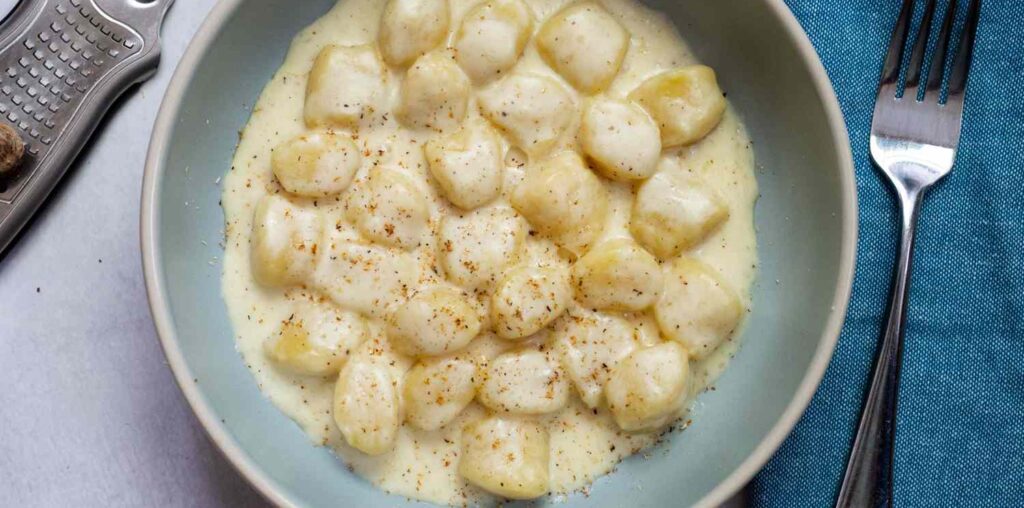Why It Works
- Homemade gnocchi that prioritize structure over ethereal lightness deliver great potato flavor while holding their shape.
- The melting properties of Fontina cheese means it can be incorporated into a creamy, smooth sauce without the need for a roux.
In the Italian Northwestern Alpine region of Valle D’Aosta, there are no olive orchards, no soft rolling hills lined with spindly cypress, no warm Mediterranean waters. Instead, road signs are written in Italian and French, vineyards are precariously etched into rocky cliffsides, and dramatic ridges rise steeply from green valleys below up to blue-grey snowy peaks, all of it presided over by Monte Bianco—Mont Blanc, if you’re on the Swiss or French sides of the border—the tallest mountain in Western Europe.
Climb the region’s winding roads higher and higher and your ears will eventually pick up a strange and marvelous music coming from nearby pastures—hundreds of bells tolling together to make a sound that’s both discordant and arrhythmic yet somehow also soothing. The unwitting musicians are the local cows, each with an oversize bell slung around its neck from a heavy leather strap, the dings and dongs sounding with each step and bite of grass.
Those cows are responsible for Fontina cheese, arguably the greatest cheese to come out of Valle D’Aosta. A member of the Alpine cheese family, which includes classics like Gruyère, Comté, and Emmentaler, Fontina is earthy, nutty, and buttery, with pleasant mushroom notes. It’s also a superb melting cheese.
That’s the secret to the region’s “bava” sauce, so named for the drool that it either elicits from diners or resembles in its melted state (or both, maybe). Fontina melts so beautifully that there’s no need for any extra techniques to help it form a smooth and stable emulsion—no butter-and-flour roux used to build cheese sauces like Mornay, no tartaric acids (whether from wine or cream of tartar) required for a successful fondue.
Simply whisk cubed Fontina over moderate heat into heavy cream with some butter, black pepper, and nutmeg, and the sauce will form. Folded with tender potato gnocchi, the result is true mountain food, rich and hearty, guaranteed to warm bellies and provide extra calories to combat that cold mountain air.
At least, the cheese will melt if you use real Fontina, the DOP version from Valle D’Aosta. This is one of those cheeses with a serious imposter problem, plagued by legal fakes coming out of everywhere from Denmark to Argentina and the United States. Could those work too? Perhaps, but I didn’t bother testing them. I’ve made the mistake of eating those facsimiles before and, if you know the flavor of real Fontina, they just won’t do. Verified Fontina tastes best, and it works, so as far as I’m concerned there’s no need to dig into it beyond that.
This may sound like snobbish dismissal of more affordable options, but I’m standing by it. Unlike a multi-cheese sauce like quattro formaggi, alla bava stars Fontina, and only Fontina. Its flavor is the sauce. Served on tender and mildly sweet potato gnocchi, there’s little for a subpar sauce to hide behind.
Speaking of those gnocchi, while some recipes for gnocchi alla bava call for using little buckwheat-flour dumplings, many others call for potato dumplings, and if you’re going to make the best version of potato gnocchi alla bava, the gnocchi must be homemade. Store-bought gnocchi (with very few exceptions) are heavy, dense, and lack what should be their signature potato flavor. The sauce itself comes together so easily that making the gnocchi really is the only real work, and it’s work that’s worthwhile. With just a little practice, it’s hardly much of a project: Bake the potatoes, scoop out the flesh and rice it, knead gently with flour and egg, form, and cook.

